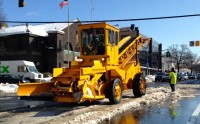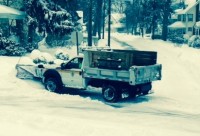White Plains Reveals Inventive Snow Removal Plan

The winter of 2013-14 is going to go down in the record books as one of the region’s worst.
In the six weeks beginning the day after New Year 2014, White Plains and the surrounding area had received from 50 to 60 inches of snow, according to Joseph (Bud) Nicoletti, Commissioner of White Plains Department of Public Works, and was looking at possibly another three to six inches over the President’s Day weekend.
“In the 29 years of storms that I’ve been working with DPW, I’ve never experienced anything like this Nicoletti said in an interview on Friday. He noted that the winter of 1996 had dumped about 80 inches of snow on White Plains, but that the temperatures had been more moderate and the storms further apart than they have been this year.

“When you have three storms in one week with temperatures in the frigid zone that do not allow the snow to melt between storms, it’s like dealing with a storm that’s dumped two feet of snow at one time,” Nicoletti said.
But never fear, Nicoletti has several tricks up his sleeve that have helped White Plains stay ahead of the fray.
It could be said that Nicoletti himself is the secret weapon that White Plains has to fight the winter storms. In actuality, it is a combination of Nicoletti and his staff’s engineering and mechanical genius as well as strategic planning that adds up to White Plains overall success – and one machine in particular. Nicoletti calls it the Snow Loader.

If you were on Mamaroneck Avenue on Friday morning, you most likely navigated the two-way street with a several foot high snow median running down the center, where the green St. Patrick’s Day stripe will soon appear. Later, during the afternoon, DPW crews were out with the snow loader, working their way down the avenue, parallel to traffic flowing in both directions, removing the snow median and carting the snow off to Gedney Yard.
With most of the city’s snow storm budget already spent on supplies as well as labor and overtime, technology like the snow loader helps to keep things running as smoothly as they can and reduces costs.
The machine was purchased by White Plains at a used vehicle auction two years ago, Nicoletti explained. “It had originally sold for $28,000, but we got it used for $18,000. It also was originally intended to move dirt, but with the addition of rubber bars to the belt, it moves snow.”

Since White Plains has been strictly enforcing its ban on overnight street parking, plows are able to work close to the curb to remove snow, allowing room for a traffic lane with the snow median in the middle. Because the snow loader works parallel to traffic instead of perpendicular to it, as with regular plows and loaders, the remaining snow can be removed during regular work hours.
“This works great on the straight a ways like Mamaroneck Avenue and we’ve already saved over $100,000 by using this machine,” Nicoletti said.
The newly capped landfill at the Gedney Yard has also proven useful this winter. “We’ve had so much snow that there’s nowhere to put it,” Nicoletti explained. The blacktopped area of the Gedney Yard with water treatment technology to purify the run-off, is being used as a snow dumping area, again saving money in snow carting charges.
“There’s a lot that goes on behind the scenes in clearing out the street during and after these storms, “Nicoletti further explained. “Because there is some melting during the day and then freezing again at night, ice builds up in the catch basins, causing water to back up. We often have to send out teams to clear up the catch basins between snow removal operations.”
The city has also been faced with seven water main breaks during the same six-week period.
Nicoletti also bemoans the recurring potholes, which he says are filled and then appear again after each storm; a difficult problem to keep up with when the fills have not fully set before the next storm strikes.
White Plains DPW Yard, off of Westchester Avenue, has a large protected storage area where the city keeps its supplies of rock salt and sand. It can store up to 4,000 tons if necessary and uses 1,000 to 1,5000 tons for each storm.
“We have enough to get us through another storm and another delivery is expected Monday,” Nicoletti said.
Because it has the room, White Plains has been storing more supplies as the weather forecasts indicate.
Depending on the expected temperatures, DPW often needs to apply calcium chloride to the regular sodium chloride (rock salt) to melt ice at temperatures below 20 degrees Fahrenheit.
“Calcium chloride is a liquid we apply to the rock salt and mix with sand,” Nicoletti explained. “There was a back-up in delivery of the liquid because of high demand and we were afraid we might not get what we needed before the next storm. We sent our own tanker on the two-hour trip to get what we needed.”
On residential streets, Nicoletti said the overnight parking ban has helped crews move faster through neighborhoods. “They don’t have to go back and remove snow left behind from a parked car and if residents are shoveling snow into the street and then call for a crew to come back and plow, the property from which the snow was plowed will be cited,” Nicoletti said.
The Mayor’s Office has also reported that residents are using the free overnight parking offered as a courtesy during extreme weather situations at the Hamilton-Main and Chester-Maple garages and that has helped to streamline snow removal.
In closing Nicoletti noted that White Plains had experienced unusually high snowfall amounts in a short period of time. For residents and business owners with a flat roof, he advised that those roofs built to code should be able to withstand two and a half to three feet of snow. Beyond that, snow removal from rooftops is encouraged to avoid roof collapse.
